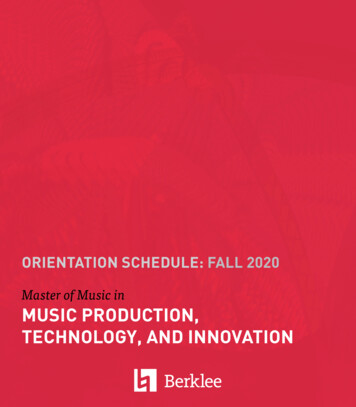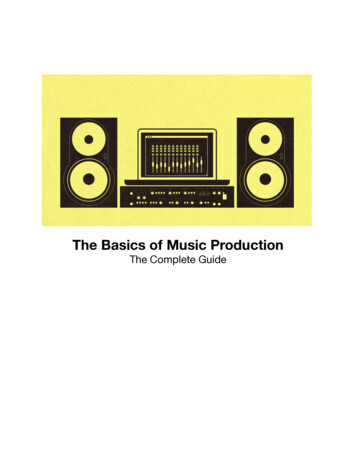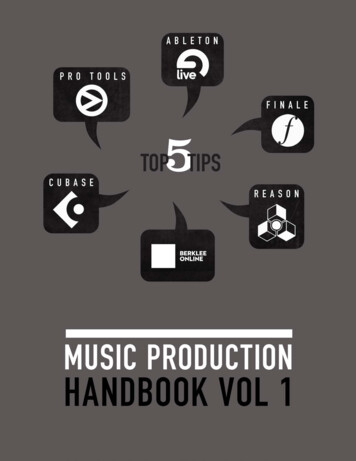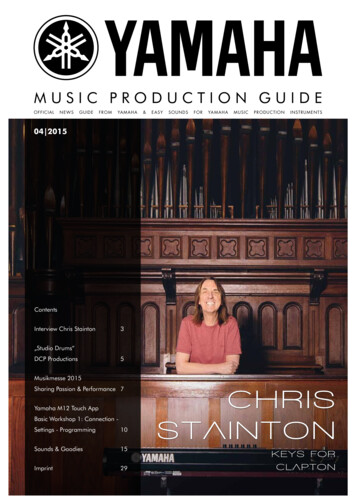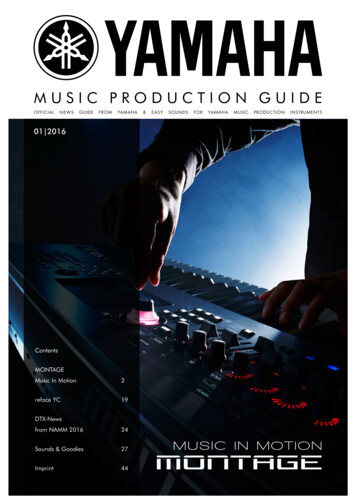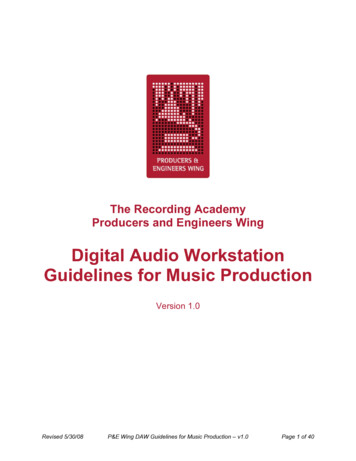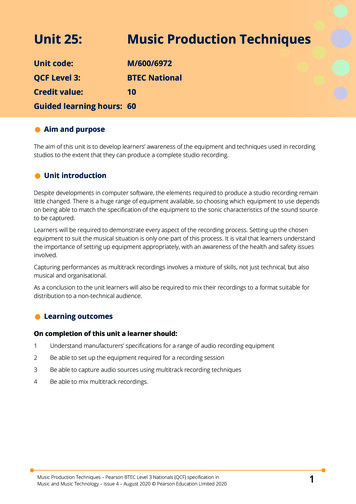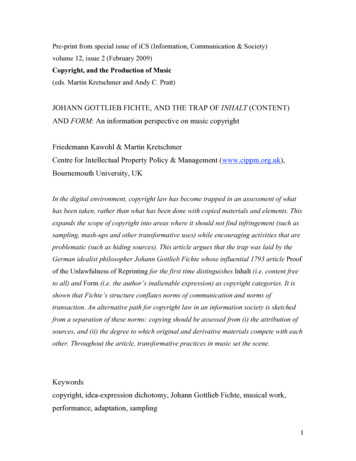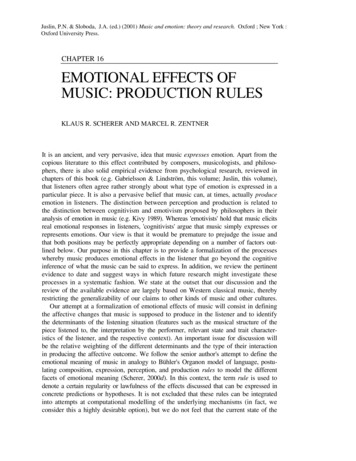
Transcription
Juslin, P.N. & Sloboda, J.A. (ed.) (2001) Music and emotion: theory and research. Oxford ; New York :Oxford University Press.CHAPTER 16EMOTIONAL EFFECTS OFMUSIC: PRODUCTION RULESKLAUS R. SCHERER AND MARCEL R. ZENTNERIt is an ancient, and very pervasive, idea that music expresses emotion. Apart from thecopious literature to this effect contributed by composers, musicologists, and philosophers, there is also solid empirical evidence from psychological research, reviewed inchapters of this book (e.g. Gabrielsson & Lindström, this volume; Juslin, this volume),that listeners often agree rather strongly about what type of emotion is expressed in aparticular piece. It is also a pervasive belief that music can, at times, actually produceemotion in listeners. The distinction between perception and production is related tothe distinction between cognitivism and emotivism proposed by philosophers in theiranalysis of emotion in music (e.g. Kivy 1989). Whereas 'emotivists' hold that music elicitsreal emotional responses in listeners, 'cognitivists' argue that music simply expresses orrepresents emotions. Our view is that it would be premature to prejudge the issue andthat both positions may be perfectly appropriate depending on a number of factors outlined below. Our purpose in this chapter is to provide a formalization of the processeswhereby music produces emotional effects in the listener that go beyond the cognitiveinference of what the music can be said to express. In addition, we review the pertinentevidence to date and suggest ways in which future research might investigate theseprocesses in a systematic fashion. We state at the outset that our discussion and thereview of the available evidence are largely based on Western classical music, therebyrestricting the generalizability of our claims to other kinds of music and other cultures.Our attempt at a formalization of emotional effects of music will consist in definingthe affective changes that music is supposed to produce in the listener and to identifythe determinants of the listening situation (features such as the musical structure of thepiece listened to, the interpretation by the performer, relevant state and trait characteristics of the listener, and the respective context). An important issue for discussion willbe the relative weighting of the different determinants and the type of their interactionin producing the affective outcome. We follow the senior author's attempt to define theemotional meaning of music in analogy to Bühler's Organon model of language, postulating composition, expression, perception, and production rules to model the differentfacets of emotional meaning (Scherer, 2000d). In this context, the term rule is used todenote a certain regularity or lawfulness of the effects discussed that can be expressed inconcrete predictions or hypotheses. It is not excluded that these rules can be integratedinto attempts at computational modelling of the underlying mechanisms (in fact, weconsider this a highly desirable option), but we do not feel that the current state of the
362MUSIC AND EMOTIONart provides the necessary precision in specifying the model parameters and the inputand output variables that would be required to pursue this aim. Thus, the term rulesand the pseudo-mathematical formulas to formalize them suggested below are used in apurely descriptive sense in this chapter.A formalization of the process by which music generates emotion requires, first of all,a definition of what exactly is to serve as the output variable, that is, the type of emotional or affective state that is supposed to be produced by music. This is necessary sincemuch of the confusion in the literature is due to a lack of conceptual clarity concerningthe hypothetical constructs involved. Scherer (2000a) has suggested a design featuredelimitation of various affective phenomena, reproduced in an adapted form in Table16.1. In view of the lack of agreement in the field, we have not attempted to identify thecharacteristics of aesthetic emotions, particularly relevant to music, either as a separatecategory or as a subcategory of the types proposed. This is a task that remains to beaccomplished in future work. We will consistently apply the distinctions suggested inTable 16.1 in this chapter, both in classifying the literature to be reviewed (which attimes requires one to speculate what an author meant or what a study measured) and informalizing mechanisms and discovery procedures. In particular, we will try to distinguish affective preferences, moods, and emotion episodes, all of which might be produced by music. Clearly, any attempt to demonstrate that these different types of statesare induced by music requires that the defining characteristics of the respective state areoperationalized and measured.The next step is to operationalize the input variables; that is, to specify in greaterdetail which aspects of listening to a piece of music are involved in the inference and/orinduction of emotion (for a more detailed example of such an analytical approach, seeDowling & Harwood 1986). We will distinguish structural, performance, listener, andcontext features, presuming that these features can, individually or in combination, produce the different affective states described above.Structural featuresWe subdivide structural features of music—that is, all those qualities of a composer'sscore that a good performer needs to respect—into segmental and suprasegmentaltypes. Segmental features consist of the acoustic characteristics of the building blocks ofmusical structure: individual sounds or tones as produced by the singing voice orspecific musical instruments. In some ways one may presume that such individualsounds correspond to the isolated affect vocalizations that may lie at the source ofspeech and music. The use of 'Ah' and 'ahimé' in baroque operas illustrates what hasbeen called the domestication of 'brute' affect vocalizations (Kainz 1962; Wundt 1900;for a review of this literature, see Scherer 1994). The closest equivalent in instrumentalmusic is the individual tone, interval, or chord. The acoustic structure of such individual tone segments, corresponding to phones in speech, is described by duration, energy(amplitude), pitch (fundamental frequency), and timbre or harmonic structure (spectral composition) of the complex wave, as well as the energy and pitch envelopes andmicrochanges in timbre over the duration of the sound. In sound or tone sequences,this acoustic information can be aggregated, yielding measures of central tendencies(mean, median) that, in relatively homogeneous sequences, can be described as the
EMOTIONAL EFFECTS OF MUSIC: PRODUCTION RULES363Table 16.1 Design feature delimitation of different affective states (adapted from Scherer (2000a))IntensityDurationSynchronizationEvent focusAppraisal elicitationRapidity of changeBehavioral impactDesign featurePreferences: evaluative judgments ofstimuli in the sense of liking or disliking,or preferring or not over anotherstimulus (like, dislike, positive, negative)LMVLVHHVLMEmotions: relatively brief episodes ofsynchronized response of all or mostorganismic subsystems in response tothe evaluation of an external or internalevent as being of major significance(angry, sad, joyful, fearful, ashamed,proud, elated, desperate)HLVHVHVHVHVHMood: diffuse affect state, mostpronounced as change in subjectivefeeling, of low intensity but relativelylong duration, often without apparentcause (cheerful, gloomy, irritable,listless, depressed, buoyant)MHLLLHHInterpersonal stances: affective stancetaken toward another person in a specificinteraction, colouring the interpersonalexchange in that situation (distant,cold, warm, supportive, contemptuous)MMLHLVHHAttitudes: relatively enduring,affectively coloured beliefs andpredispositions towards objectsor persons (liking, loving, hating,valuing, desiring)MHVLVLLLLPersonality traits: emotionally laden,stable personality dispositions andbehavior tendencies, typical for aperson (nervous, anxious, reckless,morose, hostile, envious, jealous)LVHVLVLVLVLLType of affective state:brief definition (examples)VL very low, L low, M medium, H high, VH very high.dominant acoustic structure of the sound sequence. This process of aggregation isstraightforward for some acoustic variables (e.g. pitch) and rather difficult for others(e.g. timbre). However, even in the more difficult cases approximations can be found(e.g. a rough aggregate measure of dominant timbre might be the mean proportion ofthe energy above 1 kHz).Segmental effects on emotion inference or induction are expected to be relativelystable and universal, with the exception of random error, over all types of listeners and
364MUSIC AND EMOTIONperformance conditions. Generally, such effects are mediated by evolutionarily evolvediconic signalling characteristics, based on physiological changes in affect vocalizationand relatively independent of individual or cultural differences (cf. also Rosar 1994).Suprasegmental features consist of systematic configurational changes in soundsequences over time, such as intonation and amplitude contours in speech. In music,comparable features are melody, tempo, rhythm, harmony, and other aspects of musicalstructure and form. While iconic coding also plays an important role (e.g. with respectto tempo, rising/falling contours), suprasegmental features seem to carry emotionalinformation primarily through symbolic coding, as based on a process of historicallyevolved, sociocultural conventionalization (see Kappas et al. 1991; Scherer 1988;Sloboda 1992).Performance featuresThese refer to the way in which a piece of music is executed by performer(s). Both thestable identity (physical appearance, expression, reputation) and ability (technical andinterpretative skills) of the performer, as well as transient performance-related variablesreferred to here as performance state (interpretation, concentration, motivation, mood,stage presence, audience contact, etc.), may have a major impact on the perception andinduction of emotion. The effects of performance features can be based on both iconicand symbolic coding.Listener featuresListener features are based on the individual and sociocultural identity of the listenerand on the symbolic coding convention prevalent in a particular culture or subculture. They can consist of interpretation rules (e.g. musical systems) that are shared ina group or culture, or of inference dispositions based on personality, prior experiences, and musical talent. These factors can be summarized into musical expertise,including cultural expectations about musical meaning, and stable dispositions unrelated to music, such as personality or perceptual habits. In addition, transient listenerstates such as motivational state, concentration, or mood may also affect emotionalinference from music (cf. Cantor & Zillmann 1973). In the case of listener features, wesuggest a third type of meaning-conferring coding—associative coding—in addition tothe established semiotic distinction between iconic and symbolic coding. By this wemean the fact that segmental, suprasegmental, and performance cues can be associatedwith emotional content in an individual's memory due to learned associations andconditioning.Contextual featuresThese refer to certain aspects of the performance and/or listening situation. Thus, thelocation of a performance and/or a listening situation may be a concert hall, church,open-air site, car, or recording studio. The dominant material surrounding the listener/performer may be wood, glass, stone, metal, or cement. In addition to the location, theparticular event may be a wedding, a funeral, a ball, or the celebration of an outstandingachievement. The music may be transmitted through loud-speakers, headphones, or
EMOTIONAL EFFECTS OF MUSIC: PRODUCTION RULES365without any technical support. The music may be heard without interruption or it maybe disturbed by the sirenes of an ambulance or the coughing of a concert visitor. Wesubmit that all these features can have an influence on the acoustics, the ambiance ofthe location, or the behaviour of the audience, which in turn may lead to differentemotional effects due to objective features of the situation or subjective perceptions ofthe listeners.16.1 Production rules16.1.1 PredictionsWe suggest that an emotion that is actually experienced by a listener while listening tomusic is determined by a multiplicative function consisting of several factors:Experienced emotion Structural features Performance features Listener features Contextual features,whereStructural features W1 (Segmental features) W2 (Suprasegmental features),Performance features W3 (Performer skills) W4 (Performer state),Listener features W5 (Musical expertise) W6 (Stable dispositions) W7 (Currentmotivational / mood state),andContextual features W7 (Location) W8 (Event).We postulate multiplicative rather than additive functions because it is unlikelythat any of the constituent factors in and of themselves, in the absence of otherfactors, can lead to marked, reliable emotional effects. Furthermore, it seems intuitively reasonable to assume that some listener features (e.g. musical expertise) willstrongly interact (in the statistical sense of conveying special strength or significance) with specific structural or performance features. Finally, we submit that thedifferent factors carry different weight. In fact, the order in which the variables arelisted above follows the results of a study in which experienced listeners, many ofthem experts, were asked to rate the extent to which each of the major factors listedabove was perceived to influence musical emotion induction (Scherer et al., in press).Clearly, more exploratory studies are needed before more subtle predictions can bemade and tested.After this initial formalization of the output and the input variable
EMOTIONAL EFFECTS OF MUSIC: PRODUCTION RULES 365 without any technical support. The music may be heard without interruption or it may be disturbed by the sirenes of an ambulance or the coughing of a concert visitor. We submit that all these features can have an influence on the acoustics, the ambiance of the location, or the behaviour of the audience, which in turn may lead to different .
